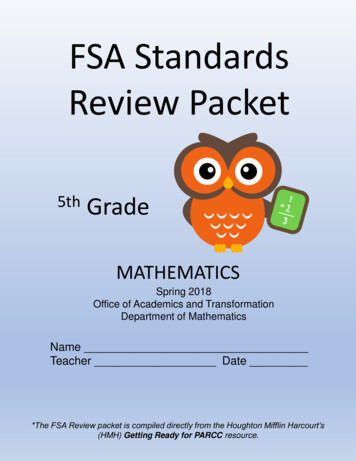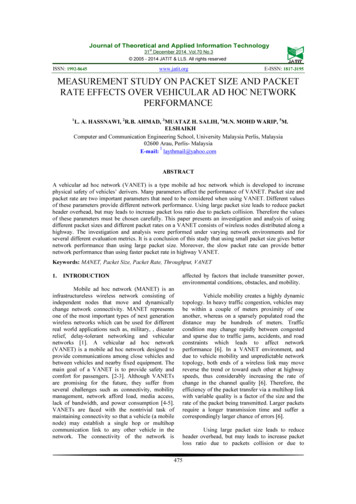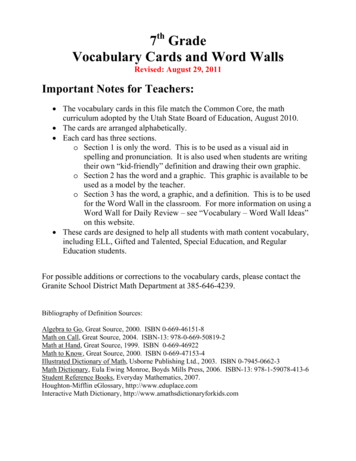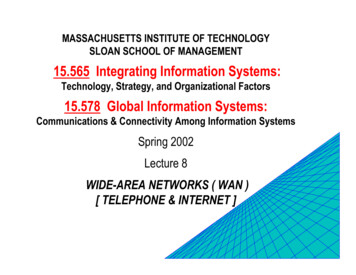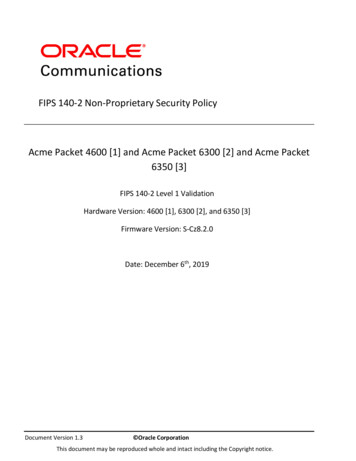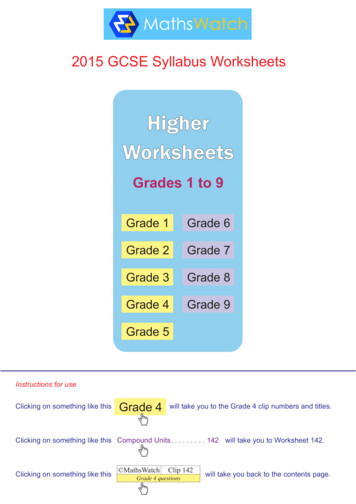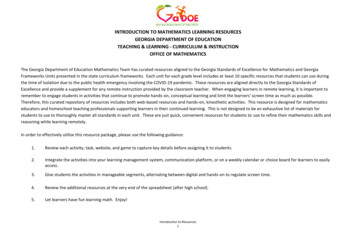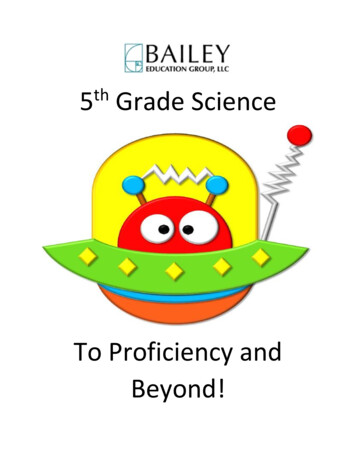
Transcription
th5 Grade ScienceTo Proficiency andBeyond!
Table of Contents Daily Assignments Vocabulary Games Days 1-3 P.5.5.A Days 4-8 P.5.5.B Days 9-10 P.5.5.C
5th grade Daily Science Assignments:Day 1Read matter student guide and answer questions 15-18 on Matter Questions sheet.For the following vocabulary words, define, draw a picture , and use in a sentence:Atom , Element, MoleculeDay 2Work P55A Independent Practice Sheets ( 2 pages)Day 3Work P55A Atom and Molecules SheetDay 4Make flash cards for the following vocabulary words and play one of the vocabularygames listed on Vocabulary Sheet: matter, atoms, molecules, proton, neutron,electron compound, heterogeneous, homogeneous, solution, mixture, solute, andsolvent, physical change, chemical changeDay 5Use Matter Student Guide to answer questions 1—14 on the Matter QuestionsSheetDay 6Read and answer questions from Mixture Reading passageDay 7Work P.5.5.B Independent Practice SheetsDay 8Use Matter Student Guide to answer questions on the Matter QuestionsSheet 19-23 and read and answer questions for States of Matter Reading PassageDay 9Read and answer questions from Physical and Chemical Properties Reading PassageDay 10Work P.5.5.C Independent Practice Sheets
Vocabulary Games and Directions:Game 1: Card Sort for Individual orGroup Review:1. Separate the vocabulary cards and definitioncards into two stacks.2. Mix / shuffle the cards in each stack.3. This is a mix/match game. Your goal is tocorrectly pair each vocabulary card with thecorrect definiton card.4. If instructed, record each term and definitionon the provided recording sheet or a piece ofnotebook paperGame 2: Catch Phrase Style1. Place the vocabulary cards facedown in a stack.2. One student draws a card, looks at the word, but does notallow the other students in the group to see the card. Thestudent drawing the card is the “clue- giver.” This studentmust describe the word, define the word, make gesturesabout the word, or give any sort of verbal clues in an attemptto get the other members of the group to guess the word.The clue- giver cannot use the word in the descrip7on, norgive out hints, such as the first letter of the word.3. Award the student guessing the word a point. The studentresponding with the correct word becomes the clue- giver inthe next round. Continue playing until all vocabulary wordshave been reviewed.Game 3: Concentration1. Spread out the vocabulary cards (facedown) on one side of thetable. Spread out the corresponding definiton cards (facedown)on the other side of the table. Cards should be placed in straightrows and columns.2. Begin game play by having one student turn over a vocabulary cardand a definition card. If there is no match, both cards are turnedfacedown in the same posi7on and play passes to the next student.3. If the cards match (the correct definition card with the vocabularycard), the student keeps the matching cards, and is allowed to tryto make another match. You must “concentrate” to rememberwhere you have seen a particular vocabulary or defini7on card.Continue play until all cards are matched. The winner is thestudent who made the most matches.
Game 4: Pictionary StyleShuffle the vocabulary cards and place them facedown onthe table.One student begins the game by drawing a vocabularycard from the deck. This student attempts to draw apicture or diagram of the vocabulary word. Otherstudents in the group will attempt to guess the vocabularyword.Game play then passes to another student in the group.Game 5: Let’s Talk About It!You will be paired with a single partner.Mix up the vocabulary cards and place them facedown.Draw 10 cards from the stack.When the teacher starts the game, you and your partnermust have a conversation in which you use (correctly!) asmany of the vocabulary words in your stack as possible.The conversation cannot consist of you reciting definitionsto one another!As you use a word, the card should be removed from yourhand and placed on the table. The game ends when youor your partner have used all 10 words on your vocabularycards
5.MATTER QUESTIONSMatter is anything that has mass and takes up space;Which of the diagrams bestshows the arrangement ofmolecules in a solid?(2006-34)and occurs as a solid, liquid, or gas. Key concepts:a.properties of each phase of matter;b.the effect of temperature on thephases of matter;c.atoms and elements;d.molecules and compounds;e.mixtures including solutionsSOLID-LIQUID-GAS – PHASES OFMATTER1. The circles in the bottlesrepresent the sameparticles of matter. Whichpattern of particlesrepresents a gas in abottle?(2005-28)6.(2005-4)7.gallium?(2004-12)The gas will expand and escape fromthe container.When light hits the gas, it will change colors.d. Gravity will keep the gas in the container.3.Oxygen, nitrogen, and carbon dioxide may be groupedtogether because at room temperature they are all a —(2001-7)a. solidb. liquidc.gasd. colloid4. Which of these will happen if the temperature of a metalpan is increased?(2001-13)a. The pan will begin to lose heat.b. The molecules of the pan will move faster.c.The metal will change into another metal.d. The pan will contract.a.It will change to a gas.b.It will change to a liquid.c.It will become a solution.d.It will become a mixture.8.When ice cream is left out ofa freezer, the ice cream9.changes from a —b. The gas will slowly change back into a liquid.c.Gallium is a metal that melts at about 30 C. If a person,whose body temperature is 37 C, held a cube of galliumfor five minutes, what will most likely happen to the(2011-18)2. What will happen if the lid is removed from a containerthat holds helium gas?a.Which picture showsa liquid at roomtemperature?(2009-4)a.solid to a gasb.gas to a liquidc.solid to a liquidd.liquid to a gas10. Which of these shows how frozen water changes asthe temperature of the air increases?(2007-17)a.Gas liquid solidb.Solid gas liquidc.Liquid gas solidd.Solid liquid gas11. The process shown wouldbe classified as rationd.evaporation
13. Which of these will change solid iron to a liquid?(2006-15)MIXTURES & SOLUTIONSa. Raising the air pressure19. Which of these is a mixture?b. Increasing its temperature(2006-13)c.Crushing the solid irond. Adding water to the iron14. Which of the following changes is possible withthe addition of heat?(2003-3)a.Saltb.Waterc.Lemonaded.Sugara. Liquid water changes to ice.20. People put sugar in their tea to make it sweet.The sugar will dissolve fastest when the tea —b. Water vapor changes to ice.(2004-16)c.Water vapor changes to liquid water.d. Ice changes to liquid water.ATOMS, ELEMENTS,MOLECULES, COMPOUNDS15. Water, ice, and steam are alike because they —a.is hotb.is coldc.is in a tall glassd.has lemon in it21. In which beaker of water will sugar dissolve the fastest?(2005-35)(2006-28)a. are the same compoundb. have the same shapec.look the samed. feel the same16. The smallest quantity of an element is —(2002-10)a. a compoundb. an atom22. A student makes a fruit drink by stirring a powdered mixinto cold water. Why is the fruit drink a solution?c.(2009-18)a solutiond. a molecule17. The smallest part of matter that is identifiable asan element is the —(2003-36)a.The powder dissolves in the water.b.The water changes color.c.The student stirs the water.d.The water is the proper temperature.a. atomb. moleculec.celld. compound18. Which of thesewill most likelyhappen to theballoon as thechemicals react?(2011-6)23. Which set of pictures shows what happens to a glassof salt water when it is left out on a counter for severalweeks?(2006-31)a. It will float.a. C D A Bb. It will break.b. A C B D c.c.B A C D d.It will inflate.d. It will change color.D B A C
P.5.5A Properties of MatterP.5.5 Organization of Matter and Chemical InteractionsPart I: Four SquareDirections: Fill in the four sections of the model to describe the vocabulary word -EXAMPLE1
P.5.5A Properties of MatterP.5.5 Organization of Matter and Chemical InteractionsPart II: Word Path FindDirections: Read the clue and find the correct word in the box by coloring the path.The first letter is shaded.SESTVITISNDAICCUDHRATOUDATLHYNDY1. The ease of scratching asmooth surface of an element3.2.The transmission of light, heat,sound, or electricity by asubstanceTFEOBYTIELRIOSOLCONNLULITIRFYIUBEnergy bouncing off ofa surface4.A solid that is able todissolve in a liquid2
S8P1a. Atoms & MoleculesName:Essential Question: How are atoms and molecules related?Part IAtoms:Elements:Molecules:Part IIIdentify whether the following is an atom, element, or molecule. Explain your answer.Draw and label your own atom, element, and molecule.
S8P1a. Atoms & MoleculesName:Part IIIIdentify the number of atoms in each of the following molecules. Use a periodic table ifneeded to identify element symbols.3.H2O4.NaCl5.CO26.NH3Part IV Summarizing StrategyQuad Clusters: Which one does not belong? Explain your answer.1.A.B.C.D.2.A.B.C.D.
P.5.5B Solutions and MixturesP.5.5 Organization of Matter and Chemical InteractionsPart I: Word FindDirections: Using the clues below, find the hidden vocabulary words and ERSJNESHENQWUZMVTSSomething made of all one materialWhen one substance mixes evenly in another substanceTwo or more substances that do not mix evenlyTo spread out evenly in a substanceCharacteristics of matter used to describeA material with tiny holes; used to sort matter of different sizesA state change from liquid to gasAbility to attract to a magnet1
P.5.5B Solutions and MixturesP.5.5 Organization of Matter and Chemical InteractionsPart II: Word ScrambleDirections: Use the clues in parentheses to help you unscramble the words. Writethe unscrambled word or phrase in the space provided.1.A type of matter with specific properties(sscetbanus)2.Physical or chemical characteristics(rptsoreiep)3.FTwo or more substances(tiemxru)6.EAllow liquid or small grains to pass through(teslrfi)5.PChanging from a liquid to a gas(taoonaepvri)4.SMMixed evenly throughout another substance(utooslin)S2
nges: Physical or Chemical?By Cindy GriggIf you have studied atoms, you know that atoms are the buildingblocks of matter. Atoms are so small they cannot be seen with anordinary microscope. Yet atoms make up everything in the universe.Atoms can combine with different atoms and make new substances.Substances can also break apart into separate atoms. These changesare called chemical changes or reactions. Chemical reactions happenwhen atoms gain, lose, or share electrons. What about when waterfreezes into ice? Do you think that's a chemical change?1When water freezes, it has changed states. You probably already know about the fourstates of matter. They are solid, liquid, gas, and plasma. Plasma is the fourth state ofmatter and is the most common state in the universe. However, it is rarely found on Earth.Plasma occurs as ball lightning and in stars. Water is a common substance that everyonehas seen in its three states of matter. Water in its solid state is called ice. Water in theliquid state is just called water. Water as a gas is called water vapor. We can easily causewater to change states by changing its temperature. Water will freeze at 32 degreesFahrenheit (0 Celsius). However, no chemical change has occurred. The atoms have notcombined or broken apart to make a different substance; it is still water or H2O. When weheat water to a temperature of 212 F. or 100 Celsius, it will change into a gas calledwater vapor. Changes in states of matter are just physical changes.2Some more examples of physical changes are tearing paper into smaller pieces,sharpening your pencil, and stirring sugar into water. When you tear a piece of paper, it isstill paper; it's just that the pieces are smaller. That is a physical change; a change you caneasily see. When you sharpen your pencil, you have only caused a physical change. Thesharpener has cut off some of the wood and maybe also some of the graphite, but theatoms of the wood and graphite have not changed chemically. You might think that theshavings you find inside the pencil sharpener are a new substance, but chemically they arenot. They are still wood and graphite in smaller pieces than the original. When you stirsugar into water, you have only caused a physical change. The glass still contains waterand sugar, but they have been mixed together. Is the sugar still there? Yes, you can taste it.This is only a physical change.3Chemical changes are different because they cause a new substance to be formed, andthey also either release energy or absorb it. Burning is a good example of a chemicalchange. When we burn wood, it releases energy in the form of heat and creates newsubstances: smoke and ash. Some signs of a chemical change are: smoking, change incolor, change in temperature, bubbling, and fizzing. Have you ever mixed vinegar andbaking soda together? If you have, you know that it bubbles! This is an example of a4http://www.edhelperblog.com/cgi-bin/vspec.cgi1/8
mical change. The new substance that is formed is carbon dioxide gas which causes thebubbles. When iron rusts, that is a chemical change. The iron changes to an orangey redcolor, a sure sign that a chemical change has happened. The iron reacts chemically withthe oxygen in the air. The new substance that is produced is rust. Chemical changes cannoteasily be undone. When wood is burned, you cannot take the smoke and ash and change itback into wood. With physical changes however, you can "undo" the change. Water can befrozen into ice; the ice can be heated until it changes back into water and heated more untilit changes into water vapor. Water vapor can condense and become water again, as it doesin the clouds when it rains.Physical changes account for our weather. The water cycle is water changingphysically from one state to another, and it gives us rain, snow, sleet, and hail. Chemicalchanges are important to people, too, because chemical changes take place when we cookand eat our food. Chemical changes are used to produce the energy we need for heatingour homes, running our electrical appliances, and driving our cars. Even breathing is achemical reaction! Perhaps the most important chemical reaction of all is photosynthesis.Plants are able to produce their own food from the energy of the sun by a set of chemicalreactions called photosynthesis. Without that, there would be no food for people. Theprocess of photosynthesis also gives people oxygen to breathe. People depend on physicaland chemical changes to live.5Copyright 2015 cgi2/8
eDateChanges: Physical or Chemical?1. When do chemical reactions happen?When matter changes statesWhen water boilsWhen water freezes into iceWhen atoms gain, lose, or shareelectrons3. Matter in the plasma state is the mostcommon in the universe.FalseTrue5. Changes in states of matter are .Chemical changesNeitherPhysical changes7. Which one of these is not a sign of achemical change?SmokingChange in colorChange in spec.cgi2. How many states of matter are there?TwoFourOneThree4. Matter in the plasma state is the mostcommon on Earth.FalseTrue6. Why are chemical changes differentfrom physical changes?A new substance is formed.They cannot be easily undone.They release energy or absorb it.All of the above8. According to the passage, what is themost important chemical reaction of all?PhotosynthesisBurning fuelRespirationEating3/8
eDateChanges: Physical or Chemical?Make a list of physical and chemical reactions named in the passage. See how many more you canthink of, and list them as 4/8
eDateChanges: Physical or Chemical?Describe what a chemical reaction 8
eDateChanges: Physical or Chemical?Describe what a physical reaction 8
nges: Physical or Chemical? - AnswerKey12345678When atoms gain, lose, or share electronsFourTrueFalsePhysical changesAll of the aboveChange in shapePhotosynthesisReturn to edHelper.comChanges: Physical or Chemical?Reading ComprehensionReading comprehensionPuzzles using Word ListWord SearchWord Search (PDF and options)Make WordsWord building activityWord building activity (with word search)Word i7/8
d Shapes (easier - one letter filled in)Word Shapes (fill in word shapes and also write the word)Word i8/8
P.5.5C Chemical and Physical ChangesP.5.5 Organization of Matter and Chemical InteractionsPart I: Word SortDirections: Write each word or phrase under the correct category in the chart.Word BankProduction of precipitateColor changeProduction of heat or lightTemperature changeHardnessPhysical ChangeMassSizeRustColorWeightProduction of gasMagneticSolubilityRelative densityInsulate heatChemical Change1
P.5.5C Chemical and Physical ChangesP.5.5 Organization of Matter and Chemical InteractionsPart II: Word ScrambleDirections: Use the clues to help you unscramble the words. Write the unscrambledword or phrase in the space provided.1.A new substance formed with different propertiese2.hUsually seen as bubblesc3.hAn increase or decrease in heat energye r5.Heating and cooling, changing shape, melting and freezings4.hCreation of a solidcc e2
5th Grade Science To Proficiency and Beyond! Table of Contents Daily Assignments Vocabulary Games Days 1-3 P.5.5.A Days 4-8 P.5.5.B Days 9-10 P.5.5.C . 5th grade Daily Science Assignments: Day 1 Read matter student guide and answer questions 15-18 on Matter Questions sheet. For the following vocabulary words, define, draw a .

